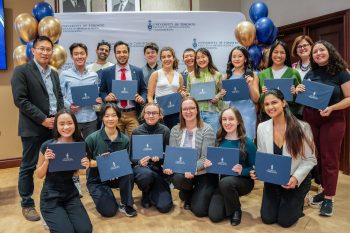January 9, 2009
By: Kate Brand, Associate Director of Communications
Every minute, ten hours of video is uploaded to YouTube. With hundreds of millions of videos watched each day and hundreds of thousands of videos uploaded every day, YouTube has emphasized an expectation among internet users: speed.
As the demand for downloading videos increases and real-time video chat becomes the next biggest thing since the telephone, the internet needs to do more than just keep up and Snowbush IP provides technology to make the internet faster.
“As transistors become smaller, microchips require both analog and digital circuits because the chips really have become systems. And, with so much design required, most companies look to purchase critical high speed analog circuits,” said U of T Engineering Professor David Johns, co-founder of Snowbush IP, a worldwide leader in analog intellectual property for microchips.
Snowbush IP licenses a variety of silicon-proven serializer/deserializer (SERDES) cores, which are a critical element of high-speed data communications and video applications, such as internet routers and HD broadcase equipment.
Snowbush offers standards-based SERDES cores, such as PCI Express®, GPON, SATA/SAS, and Gigabit Ethernet. Snowbush’s SATA cores have been so successful, there is a good chance the SATA hard-drive in your computer uses a Snowbush SERDES core.
Snowbush’s analog cores, such as high-speed data converters, enable the conversion of analog signals to digital signals, which is a key feature for such devices as set-top boxes and video cameras.
ECE Professors Johns and Ken Martin co-founded Snowbush Microelectronics in 1998, which was purchased for more than $20 million by Gennum in 2007.
“With the help from U of T Engineering graduates, Snowbush went from a small start-up company to a multi-million dollar supplier of analog design services,” said co-founder Martin, who has started a new company called Granite Semicom. “With this new venture, I hope to continue to build companies where advanced engineering is done and can hire some of the best and brightest graduates that the University of Toronto has to offer.”
Snowbush IP currently employs 40 U of T Engineering graduates and hires about three internship students from U of T Engineering’s Professional Experience Year (PEY) Internship program each year. During the 16-month internship with Snowbush, they gain a fundamental understanding of IC design engineering. Working closely with highly skilled and experienced IC designers, the PEY Internship students rotate through a variety of responsibilities.
“Through successful entrepreneurs like Professors Ken Martin and David Johns, our students gain practical hand-on experience in the classroom about microelectronics and how to be a global technology leader,” said Cristina Amon, Dean of the Faculty of Applied Science and Engineering. “U of T Engineering spin-off companies like Snowbush IP provide opportunities for Canadian engineers to provide innovative solutions to the challenges of our time.”
In 2008, Snowbush IP added approximately $10 million in revenue to its parent company, Gennum. From 1998 to 2008, Snowbush IP achieved a profitability each year with a compound annual growth rate of 46% in revenue. Since its inception eleven years ago, Snowbush IP has been shipped in over 200 million products.
Gennum acquired Snowbush to introduce more innovative analog and mixed signal solutions to serve new, high-growth consumer connectivity markets while further securing market share in Gennum’s traditional video and data communication segments, according to President and CEO of Gennum, Dr. Frank Fink.
Snowbush IP has design centres in Aguascalientes, Mexico, San Jose, California and Spokane, Washington State.
Professor Martin has been a consultant for many industry-leading microelectonics companies, was a tenured professor at UCLA and holds an endowed professorship in Engineering at U of T. He received his BASc from EngSci, MASc, and PhD degrees from U of T Engineering.
Professor Johns is a graduate of the U of T Engineering Science Electrical Engineering program. He received his MASc and PhD from U of T Engineering as well. He has been with U of T since 1988, and is currently a full professor.
Professors Johns and Martin have published more than 200 technical design papers, are inventors or co-inventors on numerous patents, and co-authored the textbook Analog Integrated Circuit Design. They are both Fellows of IEEE.



